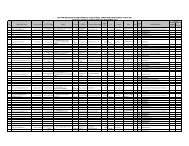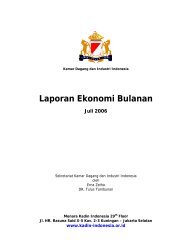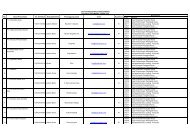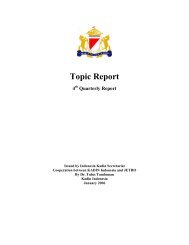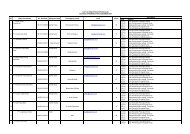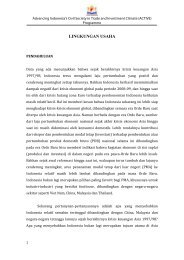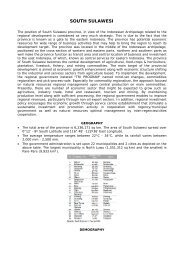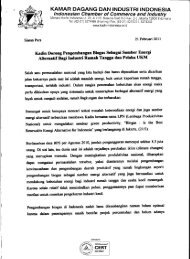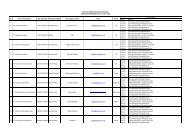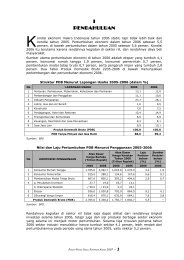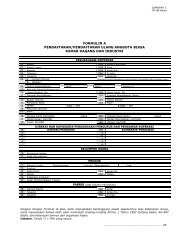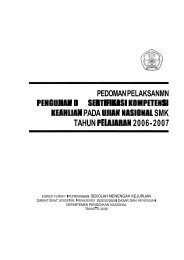Global Economic Outlook and Strategy - Kadin Indonesia
Global Economic Outlook and Strategy - Kadin Indonesia
Global Economic Outlook and Strategy - Kadin Indonesia
Create successful ePaper yourself
Turn your PDF publications into a flip-book with our unique Google optimized e-Paper software.
February 28, 2008<br />
<strong>Global</strong> <strong>Economic</strong> <strong>Outlook</strong> <strong>and</strong> <strong>Strategy</strong><br />
Slow growth should<br />
contain inflation.<br />
The course of global<br />
growth depends on<br />
financial conditions.<br />
The Citi FCI has tightened<br />
despite Fed easing.<br />
The fiscal package will<br />
provide a temporary<br />
boost.<br />
Inflation likely will cool in<br />
the second half.<br />
strong records of pursuing stable macroeconomic policies. This should make it possible<br />
for these countries to ease policy, if needed, even in the midst of substantial turmoil in<br />
global financial markets.<br />
Strong commodity prices <strong>and</strong> declining output gaps in some countries are putting<br />
upward pressure on inflation. Nonetheless, we expect the slowdown in the United<br />
States <strong>and</strong> Western Europe to contain inflation in those countries (see Figure 7), <strong>and</strong><br />
slowing export growth should help to contain inflationary pressures in other key<br />
countries such as China.<br />
The evolution of financial conditions remains a key source of uncertainty. In recent<br />
days, credit, equity, <strong>and</strong> other financial markets seem to have found a footing in<br />
response to the significant shift in Federal Reserve policy in late January, the U.S. fiscal<br />
stimulus package, <strong>and</strong> other policy measures intended to address some of the stress<br />
points in the financial system. However, even if financial markets stabilize <strong>and</strong> improve<br />
from here, the cumulative impact of the financial turmoil of the last six months is likely<br />
to be a drag on the U.S. <strong>and</strong> global economy for many months. Moreover, given the<br />
still considerable uncertainty about the magnitude <strong>and</strong> distribution of losses in the<br />
financial system, we cannot be confident that we have seen the worst in financial<br />
markets.<br />
U.S. Financial Conditions Critical to the <strong>Outlook</strong><br />
Our composite measure of U.S. financial conditions has tightened since our last forecast<br />
round (see Figure 4). Currently, the Citi financial conditions index (FCI) is about two<br />
st<strong>and</strong>ard deviations tighter than normal, a reading consistent with anemic economic<br />
growth. Recent data, particularly the deceleration of consumption since November,<br />
appear consistent with the deterioration in financial conditions since last summer. The<br />
Federal Reserve seems likely to lower policy rates further in an attempt to offset the<br />
adverse dynamic starting to take hold. Importantly, forecasts of a sustained<br />
improvement in the pace of activity later this year depend on a recovery in financial<br />
conditions.<br />
The recently enacted fiscal stimulus package will boost economic growth later this year<br />
— most likely in the third quarter — but its impact on activity will be temporary. The<br />
lift in household disposable income from the rebate checks could underpin consumer<br />
spending growth that is about 2½ percentage points faster than otherwise would be the<br />
case. But because this is a one-time boost to household income, the step up in spending<br />
will be largely reversed out in ensuing quarters.<br />
An additional 100-basis-point decline in the funds rate is likely despite the continued<br />
stickiness in inflation. Consumer <strong>and</strong> wholesale inflation readings in January were<br />
disappointing, <strong>and</strong> our latest forecast anticipates slightly higher core inflation this year.<br />
As long as inflation expectations remain anchored near current levels, however, the<br />
combination of soft dem<strong>and</strong>, tight financial conditions, <strong>and</strong> falling home prices should<br />
produce a cooling in price pressures. The timetable for such a cooling probably will be<br />
deeper into the year than we previously envisioned. As key Fed officials continue to<br />
remind market participants, an unmooring of pricing attitudes could upend expectations<br />
of an easing in inflation. So, we will continue to monitor developments on this front<br />
closely.<br />
5




